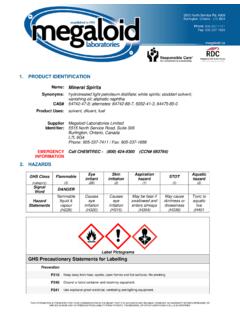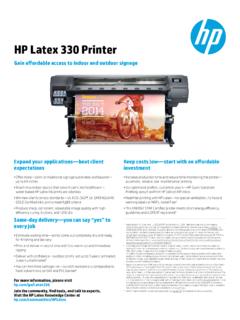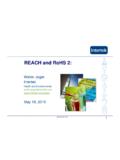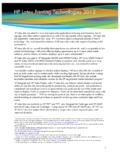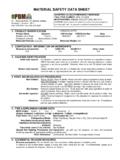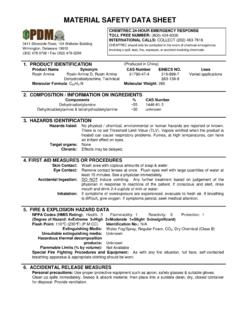Transcription of Safety Data Sheet - Megaloid
1 Product Name: Aromatic 100 Please ensure that this msds is given to, and explained to people using this product. 1 Safety data Sheet 1. PRODUCT IDENTIFICATION Name Aromatic 100 Synonyms light aromatic solvent naphtha (petroleum) high flash point aromatic naphtha, Solvesso CAS# 64742 95 6 Europe EC# 265 199 0 Product Uses high flash point hydrocarbon solvent, diluent, in paints, coatings, inks, degreasers etc EMERGENCY INFORMATION Canada Call CANUTEC (collect) (613) 996 6666 Call CHEMTREC (800) 424 9300 2. HAZARDS GHS Class flammable carcinogen aspiration haz. (Category) (3) (2) (2) Signal Words WARNING WARNING WARNING Hazard Statements flammable suspected of may be harmful liquid & vapour causing cancer if swallowed and (H226) (H351) enters airways (H304) Canada WHMIS B 3, D 2B Key: B 2 Flash Point <38 o C, B 3 Flash Point >38 o C &<93 o C D 1 Immediately Toxic, D 2 Chronic Toxicity C Oxidising Substance, E Corrosive, F Reactive Substance 3.
2 COMPOSITION CAS # % TWAEV / TLV mg/m 3 LD50 (mg/kg) ORAL LD50 (mg/kg) SKIN LC50 ppm INHALATION Light Aromatic Solvent Naphtha 64742 95 6 100% not listed >2900 >3160 2900 1,2,4 trimethylbenzene 95 63 6 10 45% 25 / 125 5000 not known 3665 cumene 98 82 8 0 6% 50 / 250 1400 2035 7950 xylene 1330 20 7 0 3% 100 / 435 2100 1700 5000 NOTE: This is a distillation productcomposed of many molecular species. Only the major components are named above. 4. FIRST AID SKIN: Wash with soap &plenty of water. Remove contaminated clothing and do not reuse until thoroughly laundered. EYES: Wash eyes with plenty of water, holding eyelids open. Seek medical assistance promptly if there is irritation. INHALATION: Remove from contaminated area promptly. CAUTION: Rescuer must not endanger himself! If breathing stops, administer artificial respiration and seek medical aid promptly.
3 INGESTION: Give plenty of water to dilute product. Do not induce vomiting (NOTE below). Keep victim quiet. If vomiting occurs, lower victim s head below hips to prevent inhalation of vomited material. Seek medical help promptly. Inadvertent inhalation ofvomited material may seriously damage the lungs. The danger of this is greater than the risk of poisoning through absorption of this relatively low toxicity substance. The stomach should only be emptied under medical supervision, and after the installation of an airway to protect the Name: Aromatic 100 Please ensure that this msds is given to, and explained to people using this product. 2 5. FIRE FIGHTING & FLAMMABILITY Flash Point 41 o C / 106 o F (closed cup) Autoignition Temperature 463 o C / 865 o F Flammable Limits 7% Combustion Products carbon monoxide, nitrogen oxides, smoke, part oxidised hydrocarbon fragments Firefighting Precautions foam, dry chemical, water fog, water spray only to cool & dilute, product floats on water water jet spreads flames firefighters must wear SCBA Static Charge Accumulation readily accumulates a static charge on agitation or pumping 6.
4 ACCIDENTAL RELEASE MEASURES Leak Precaution dyke to control spillage and prevent environmental contamination Handling Spill ventilate contaminated area recover free liquid with explosion proofpumps absorb residue on an inert sorbent, sweep & pick up using plastic or aluminium shovel, & store in closed containers for recycling or disposal 7. HANDLING & STORAGE Store in a cool, dry environment, away from sources of ignition, heat and oxidising agents. The use ofnon sparking bronze or aluminium hand tools, and explosion proof electrical & mechanical equipment (including lighting, switchgear and forklift trucks) is recommended around this product. Despite the high flash point, it is prudent to ground or electrically bond both the source container and the receiving container, and transfer pump before transferring contents. Avoid splashing by ensuring that the product nozzle is below the surface in the receiving container.
5 Empty containers may contain a flammable / explosive vapour. Always ensure that containers, whether empty or full, or part full, are tightly sealed unless in use. Avoid generating or breathing product vapour. Use with adequate ventilation. If dealing with a spill, and ventilation is impossible or impractical, wear a suitable respirator with organic vapour cartridge. Never cut, drill, weld or grind on or near this container. Avoid prolonged contact with skin and wash work clothes frequently. An eye bath and Safety shower must be available near the workplace. 8. EXPOSURE CONTROL & PERSONAL PROTECTION Trimethylbenzene: Ontario TWAEV 25ppm / 123mg/m 3 Ontario STEV not listed ACGIH TLV 25ppm / 123mg/m 3 ACGIH STEL not listed OSHA PEL 25ppm / 120mg/m 3 OSHA STEL not listed Cumene: Ontario TWAEV 50ppm / 245mg/m 3 Ontario STEV not listed ACGIH TLV 50ppm / 246mg/m 3 ACGIH STEL not listed OSHA PEL 50ppm / 245mg/m 3 OSHA STEL not listed Xylene (Dimethylbenzene).
6 Ontario TWAEV 100ppm / 435mg/m 3 Ontario STEV 150ppm / 650mg/m 3 ACGIH TLV 100ppm / 434mg/m 3 ACGIH STEL 150ppm / 651mg/m 3 OSHA PEL 100ppm / 435mg/m 3 OSHA STEL 150ppm / 655mg/m 3 Ventilation mechanical ventilation may be required to control airborne titre to regulated limits Hands Viton gloves recommended other types may also protect consult supplier to confirm suitability Eyes Safety glasses with side shields always protect the eyes Clothing no special protective clothing required if normal industrial hygiene is practisedProduct Name: Aromatic 100 Please ensure that this msds is given to, and explained to people using this product. 3 9. PHYSICAL PROPERTIES Odour & Appearance clear, colourless liquid with mild aromatic hydrocarbon (diesel fuel) odour Odour Threshold Vapour Pressure 6mmHg / (20 o C / 68 o F) Evaporation Rate (Butyl Acetate = 1) Vapour Density(air = 1) 4 Boiling Range 149 182 o C / 300 360 o F Freezing Point 60 o C / 76 o F Specific Gravity (20/20 o C) Water Solubility 200milligrams per litre slight Also soluble in most organic solvents Log PO/W (Octanol/H2O partition) (calculated) Viscosity (25 o C / 77 o F) pH none (does not liberate hydrogen ions when dissolved) Molecular Weight mixture of hydrocarbons approximately 120grams/mole 10.
7 REACTIVITY Dangerously Reactive With strong oxidising agents chlorine, fluorine, strong acids (eg: nitric acid) Also Reactive With none known Stability stable will not polymerize Decomposes in Presence of not known Decomposition Products none apart from Hazardous Combustion Products Sensitive to Mechanical Impact no 11. TOXICITY Effects, Acute Exposure Skin Contact may irritate, drying Skin Absorption slight no toxic effects likely by this route Eye Contact liquid mildly irritating vapour irritating above 75ppm will not damage Inhalation irritating above 75ppm high concentrations may cause headache, dizziness drowsiness Ingestion headache, dizziness, drowsiness are possible not a typical route of industrial exposure Effects, Chronic Exposure General prolonged exposure may cause dermatitis & skin cracking organic solvent syndrome with fatigue, memory loss, tingling & numbness in limbs wereseen after long term exposure Sensitising not a sensitiser in humans or animals Carcinogen/Tumorigen cumene is a possible human carcinogen (IARC 2B)
8 Reproductive Effect probablyno effect in humans or animals without also causing maternal toxicity, however, xylene was a suspected reproductive toxin on thin evidence Mutagen no known effect on humans or in animals without also causing maternal toxicity Synergistic With not known LD50 (oral) 2900 3200mg/kg (rat), 8400mg/kg (rat) LD50 (skin) >3160mg/kg (rabbit) LC50 (inhalation) approx. 2900ppm (rat)Product Name: Aromatic 100 Please ensure that this msds is given to, and explained to people using this product. 4 12. ECOLOGICAL INFORMATION Bioaccumulation expected to be readily metabolised and not bioaccumulate Biodegradation expected to degrade readily and rapidly in the presence of oxygen 72% over 20 days Natural microbe populations need several weeks of acclimatisation before they can metabolise some hydrocarbons effectively.
9 Abiotic Degradation many aromatic hydrocarbons are susceptible to both direct and indirect photolysis the rate of degradation is unknown but life in air likely to be in the range of 20 40hr Mobility in soil, water expected to move slowly in soil and water Aquatic Toxicity LC50 (Fish, 96hr) 41 & 45mg/litre (Pimephelas promelas), , (Oncorhynchus mykiss), 119mg/litre (Alburnus alburnus), 82mg/litre (Cyprinodon variegatus), EC50 (Crustacea, 24hr) , 170 & 226mg/litre (Daphnia magna) EC50 (Algae) 19 & 56mg/litre (Selenastrum capricornutum), (Skeletonema costatum) EC50 (Bacteria) no data since it is readily biodegradable, aromatic 100 cannot be very toxic to bacteria .. The variability in the data is probably due to the difficulty of suspending a hydrophobic product in water. Also, this product is lighter than water, readily separates out to float on the surface and then volatilise.
10 Because of this, Aromatic 100 cannot be considered very toxic to aquatic life. 13. DISPOSAL Waste Disposal do not flush to sewer, recycle solvent if possible, may be incinerated in approved facility Containers Drums should be reused. Recondition and pressure test by a licensed reconditioner prior to re use. Pails must be vented and thoroughly dried prior to crushing and recycling. IBCs (intermediate bulk containers): polyethylene bottle must be pressure tested & recertified at 30 months. Replace at 60 months (5yrs). Steel containers must be inspected, pressure tested & recertified every 5 years. Never cut, drill, weld or grind on or near this container, even if empty 14. TRANSPORT CLASSIFICATION Canada TDG PIN UN 1268 AND Shipping Name PETROLEUM PRODUCTS (naphtha) 49 CFR Class & Packing Group 3 (III) Marine Pollutant not a marine pollutant ERAP Required NO 15.

